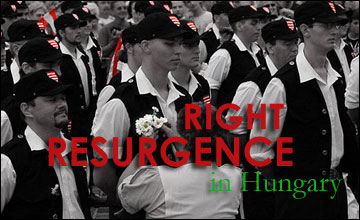Marching Back to the Future: Magyar Garda and the Resurgence of the Right in Hungary
Marching Back to the Future: Magyar Garda and the Resurgence of the Right in Hungary
One Sunday morning in December 2007, some three hundred extreme nationalists dressed in black uniforms marched in military formation through a Hungarian village, protesting against what they called “Roma [Gypsy] delinquency.” They then gathered at a rally, where speakers demanded that Roma be segregated from mainstream society. The protesters were members of the Magyar Garda (Hungarian Guard), a new ultranationalist organization whose members pledge to defend Hungarian values and culture. The Magyar Garda is an offshoot of the far-right Jobbik Magyarországért Mozgalam (Movement for a Better Hungary), generally shortened to Jobbik. Jobbik is a play on words in Hungarian, meaning both “better” and “more to the right.” Jobbik has no members of Parliament, but is represented on several local councils, where its representatives often cooperate with Fidesz, the main conservative opposition party. Opinion polls usually give Jobbik 2 percent or 3 percent support, and the Garda boasts around 650 members.
 Yet these numbers are deceptive: in Hungary’s febrile political atmosphere, the Garda dominated the political and media agenda for several months last year, continues to receive substantial press coverage, and has an effect on political life out of all proportion to its numbers. The Garda has triggered anger and consternation across the spectrum, soured the parliamentary atmosphere, increased social tension between Roma and non-Roma, and disrupted relations with Hungary’s neighbors. Jewish and Roma groups have demanded that the Garda be banned. The late U.S. Representative Tom Lantos, himself a survivor of the Hungarian Holocaust, angrily warned that no Garda member would ever be allowed to enter the United States; Hungarian prime minister Ferenc Gyurcsany proclaimed dramatically that “Fascists were gathering.” Yet paradoxically, the Garda may also have inadvertently provided a useful service for this post-communist country that in some ways is still in transition between two systems, by defining the limits of free—and hate—speech.
Yet these numbers are deceptive: in Hungary’s febrile political atmosphere, the Garda dominated the political and media agenda for several months last year, continues to receive substantial press coverage, and has an effect on political life out of all proportion to its numbers. The Garda has triggered anger and consternation across the spectrum, soured the parliamentary atmosphere, increased social tension between Roma and non-Roma, and disrupted relations with Hungary’s neighbors. Jewish and Roma groups have demanded that the Garda be banned. The late U.S. Representative Tom Lantos, himself a survivor of the Hungarian Holocaust, angrily warned that no Garda member would ever be allowed to enter the United States; Hungarian prime minister Ferenc Gyurcsany proclaimed dramatically that “Fascists were gathering.” Yet paradoxically, the Garda may also have inadvertently provided a useful service for this post-communist country that in some ways is still in transition between two systems, by defining the limits of free—and hate—speech.
The Garda was launched in August 2007, when its first fifty-six members—a number chosen to commemorate the 1956 revolution—were inaugurated by Lajos Fur, a former minister of defense in Hungary’s first post- communist government, run by the Hungarian Democratic Forum (MDF). They paraded in Budapest’s historic Castle District, in front of the home of Hungary’s president, Laszlo Solyom, holding the Hungarian flag and the ancient “Arpad” banner of red and white stripes. They wore black boots, black trousers, black sleeveless vests and white shirts, and black caps emblazoned with the Arpad stripes. The symbolism seemed obvious: a homage to Mussolini, if not Hitler, and to the fusion between race, state, and national unity. The “Arpad” stripes are a part of Hungary’...
Subscribe now to read the full article
Online OnlyFor just $19.95 a year, get access to new issues and decades' worth of archives on our site.
|
Print + OnlineFor $35 a year, get new issues delivered to your door and access to our full online archives.
|






